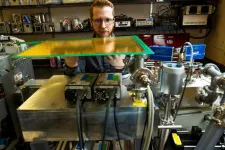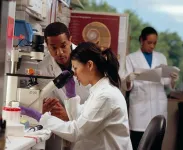(Press-News.org) Nearly half of parents who relied on formula to feed their babies during the infant formula shortage last year resorted to potentially harmful feeding methods, according to a survey from researchers at the University of California, Davis. The study was published in the journal BMC Pediatrics.
In an online anonymous survey of U.S. parents, the number of individuals that used at least one unsafe feeding practice increased from 8% before the formula shortage to nearly 50% during the shortage. Unsafe practices included watering down formula, using expired or homemade formula, or using human milk from informal sharing.
The percentage of parents who shared human milk increased from 5% to 26%, and the percentage using watered-down formula increased from 2% to 29% during the shortage.
“These are alarming statistics. The infant formula shortage increased food insecurity and threatened the nutrition of millions of American infants,” said lead author Jennifer Smilowitz, a faculty affiliate with the UC Davis Department of Food Science and Technology. “Our survey found that parents were not offered many safe alternatives and resorted to unsafe methods in an attempt to feed their infants.”
The study also sought to understand what parents experienced during the crisis to find ways to prevent future infant feeding crises in the future.
Too few formula manufacturers, milk banks
In 2022, the U.S. had a severe shortage of infant formula due to a recall by Abbott Nutrition and the voluntary shutdown of its Michigan manufacturing plant. Abbott is the largest formula maker in the U.S. and provides over 40% of the country’s infant formula. This shortage was made worse by trade policies that made it harder to import formula. By the end of May 2022, some states had an out-of-stock rate as high as 90%.
The Special Supplemental Nutrition Program for Women, Infants, and Children, or WIC, serves more than 40% of U.S. infants and accounts for more than half of infant formula consumption. Abbott Nutrition had dominated most of the WIC contracts in the U.S.
“Ninety percent of the infant formula sold in the U.S. is sold by four companies," Smilowitz said. "This has resulted in systemic failures that inequitably impact low-income communities.”
The survey found that parents also used pasteurized human donor milk from milk banks, an alternative and safe method. Smilowitz said that alternative is limited by the small number of milk banks in the U.S. and by the expense. Donor milk costs from $3 to $5 per ounce. During the shortage, parents who turned to milk banks increased from 2% to 26%.
Limited options for lower-income parents
Smilowitz said the study points to the need for policy changes within the regulatory and healthcare systems to provide families with clinical prenatal and postnatal lactation support, access to banked donor milk and access to more commercially available products.
Additionally, workplace policies need to change to support the needs of breastfeeding women. Inadequate family leave can result in earlier formula feeding. Some workplace policies don’t support the privacy and time needed for pumping. These policies disproportionately affect low-income parents.
“We should not forget what happened during this formula shortage," Smilowitz said. "Another crisis is looming if healthcare, workplace and regulatory policies in the U.S. do not systemically change."
Smilowitz said she hopes the infant formula shortage will not have health consequences for infants.
“We have this generation of children affected by the formula shortage and we won’t know for maybe a decade if there was an impact on brain development,” Smilowitz said. “We can only hope that the shortage resulted in only acute effects and that infants will be robust enough to overcome any potential long-term problems."
Karina Cernioglo, a fourth-year medical student at UC Davis, co-authored the study. The funding for the study was supported by the 2020 UC Davis Chancellor’s Innovation Award.
END
Unsafe feeding methods spiked during infant formula shortage
Alarming rate of unsafe practices points to need for systemic change in the US
2023-06-27
ELSE PRESS RELEASES FROM THIS DATE:
Illinois study reveals genetic secrets of America's favorite snack
2023-06-27
URBANA, Ill. – In its simplest form, popcorn is pretty uncomplicated. Most supermarket varieties offer the choice of two kernel colors, yellow or white, and two kernel shapes, pointed or pearl. When popped, the flake typically expands into one of two shapes: mushroom or butterfly. But there’s more to popcorn than meets the eye. New research from the University of Illinois Urbana-Champaign reveals a wealth of untapped diversity lurking in popcorn’s genetic code.
Analyzing 320 publicly available popcorn lines, crop sciences researchers found variation at more ...
UC Irvine scientists develop freely available risk model for hurricanes, tropical cyclones
2023-06-27
Irvine, Calif., June 27, 2023 — As human-driven climate change amplifies natural disasters, hurricanes and typhoons stand to increase in intensity. Until now, there existed very few freely available computer models designed to estimate the economic costs of such events, but a team of researchers led by Jane W. Baldwin at the University of California, Irvine recently announced the completion of an open-source model that stands to help countries with high tropical cyclone risks better calculate just how much those storms will impact their people and their economies.
“Tropical cyclones are some of the most impactful natural disasters on Earth. They pose huge risks ...
New model provides unprecedented window into human embryonic development
2023-06-27
Two to three weeks after conception, an embryo faces a critical point in its development. In the stage known as gastrulation, the transformation of embryonic cells into specialized cells begins. This initiates an explosion of cellular diversity in which the embryonic cells later become the precursors of future blood, tissue, muscle, and more types of cells, and the primitive body axes start to form. Studying this process in the human-specific context has posed significant challenges to biologists, but new research offers an unprecedented window into this point in time in ...
Deaf mice can have virtually normal auditory circuitry: implications for cochlear implants
2023-06-27
Researchers at Johns Hopkins University, US, led by Calvin Kersbergen report that mice with the most common form of human congenital deafness develop normal auditory circuitry – until the ear canal opens and hearing begins. Publishing June 27th in the open access journal PLOS Biology, the study suggests that this is possible because spontaneous activity of support cells in the inner ear remains present during the first weeks of life.
Mutations to the protein connexin 26 are the most common cause of hearing loss at birth, accounting for more than 25% of genetic hearing loss worldwide. To understand how these mutations lead to deafness ...
Deaf mice have nearly normal inner ear function until ear canal opens
2023-06-27
**EMBARGOED TILL TUESDAY, JUNE 27, AT 2 P.M. ET**
For the first two weeks of life, mice with a hereditary form of deafness have nearly normal neural activity in the auditory system, according to a new study by Johns Hopkins Medicine scientists. Their previous studies indicate that this early auditory activity — before the onset of hearing — provides a kind of training to prepare the brain to process sound when hearing begins.
The findings are published June 27 in PLOS Biology.
Mutations in Gjb2 cause more than a quarter of all hereditary forms of hearing loss at birth in people, according to some estimates. The connexin 26 protein coded by ...
Chemists are on the hunt for the other 99 percent
2023-06-27
The universe is awash in billions of possible chemicals. But even with a bevy of high-tech instruments, scientists have determined the chemical structures of just a small fraction of those compounds, maybe 1 percent.
Scientists at the Department of Energy’s Pacific Northwest National Laboratory (PNNL) are taking aim at the other 99 percent, creating new ways to learn more about a vast sea of unknown compounds. There may be cures for disease, new approaches for tackling climate change, or new chemical or biological threats lurking in the chemical universe.
The work is part of an initiative known as m/q or “m over q”—shorthand ...
Easier access to opioid painkillers may reduce opioid-related deaths
2023-06-27
Increasing access to prescription opioid painkillers may reduce opioid overdose deaths in the United States, according to a Rutgers study.
“When access to prescription opioids is heavily restricted, people will seek out opioids that are unregulated,” said Grant Victor, an assistant professor in the Rutgers School of Social Work and lead author of the study published in the Journal of Substance Use and Addiction Treatment. “The opposite may also be true; our findings suggest that restoring easier access to opioid pain medications may protect against fatal overdoses.”
America’s opioid crisis has ...
Fear of being exploited is stagnating our progress in science
2023-06-27
Science is a collaborative effort. What we know today would have never been, had it not been generations of scientists reusing and building on the work of their predecessors.
However, in modern times, academia has become increasingly competitive and indeed rather hostile to the individual researchers. This is especially true for early-career researchers yet to secure tenure and build a name in their fields. Nowadays, scholars are left to compete with each other for citations of their published work, awards and funding.
So, understandably, many scientists have grown unwilling ...
New findings on hepatitis C immunity could inform future vaccine development
2023-06-27
A new USC study that zeros in on the workings of individual T cells targeting the hepatitis C virus (HCV) has revealed insights that could assist in the development of an effective vaccine.
Every year, hepatitis and related illnesses kill more than one million people around the world. If unaddressed, those deaths are expected to rise—and even outnumber deaths caused collectively by HIV, tuberculosis and malaria by 2040.
For that reason, the World Health Organization and other leading groups have pledged to work toward eliminating viral hepatitis by 2030. While there are vaccines for two of the three most common ...
Cooperation between muscle and liver circadian clocks, key to controlling glucose metabolism
2023-06-27
Collaborative work by teams at the Department of Medicine and Life Sciences (MELIS) at Pompeu Fabra University (UPF), University of California, Irvine (UCI), and the Institute for Research in Biomedicine (IRB Barcelona) has shown that interplay between circadian clocks in liver and skeletal muscle controls glucose metabolism. The findings reveal that local clock function in each tissue is not enough for whole-body glucose metabolism but also requires signals from feeding and fasting cycles to properly maintain glucose levels in the ...
LAST 30 PRESS RELEASES:
An ‘illuminating’ design sheds light on cholesterol
Who is more likely to get long COVID?
Study showcases resilience and rapid growth of “living rocks”
Naval Research Lab diver earns Office of Naval Research 2025 Sailor of the Year
New Mayo-led study establishes practical definition for rapidly progressive dementia
Fossil fuel industry’s “climate false solutions” reinforce its power and aggravate environmental injustice
Researchers reveal bias in a widely used measure of algorithm performance
Alcohol causes cancer. A study from IOCB Prague confirms damage to DNA and shows how cells defend against it
Hidden viruses in wastewater treatment may shape public health risks, study finds
Unlock the power of nature: how biomass can transform climate mitigation
Biochar reshapes hidden soil microbes that capture carbon dioxide in farmland
Reducing saturated fat intake shows mortality benefit, but only in high-risk individuals
Manta rays create mobile ecosystems, study finds
Study: Mixed results in using lipoic acid to treat progressive multiple sclerosis
Norbert Holtkamp appointed director of Fermi National Accelerator Laboratory
New agentic AI platform accelerates advanced optics design
Biologists discover neurons use physical signals — not electricity — to stabilize communication
Researchers discover that a hormone can access the brain by hitchhiking
University of Oklahoma researcher awarded funding to pursue AI-powered material design
Exploring how the visual system recovers following injury
Support for parents with infants at pediatric check-ups leads to better reading and math skills in elementary school
Kids’ behavioral health is a growing share of family health costs
Day & night: Cancer disrupts the brain’s natural rhythm
COVID-19 vaccination significantly reduces risk to pregnant women and baby
The role of vaccination in maternal and perinatal outcomes associated with COVID-19 in pregnancy
Mayo Clinic smartwatch system helps parents shorten and defuse children's severe tantrums early
Behavioral health spending spikes to 40% of all children’s health expenditures, nearly doubling in a decade
Digital cognitive behavioral treatment for generalized anxiety disorder
Expenditures for pediatric behavioral health care over time and estimated family financial burden
Air conditioning in nursing homes and mortality during extreme heat
[Press-News.org] Unsafe feeding methods spiked during infant formula shortageAlarming rate of unsafe practices points to need for systemic change in the US


